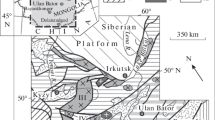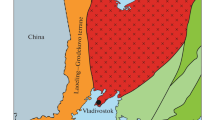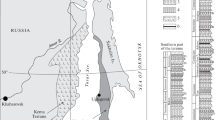Abstract
It has been found that the origin of the Patom Crater is related to endogenous processes with the main role played by deep flow of fluid components, which determine formation of the ejecta cone at about 500 years ago or more. This is evidenced by the zonal structure of the crater and geochemical peculiarities of rocks, caused by the long formation time for particular zones. Sandstone and schist blocks that were included into eruptive breccia within the crater were affected by gaseous or fluid components and intensively carbonized. During carbonatization, these rocks within the crater were being enriched in Ca and Sr, but the shares of the 87Sr and, consequently, 87Sr/86Sr ratio in them abruptly decrease. This is explained by the influence of deep fluids on terrigenous rocks, which were initially depleted in the radiogenic strontium isotope and might flow from a magmatic source with a low 87Sr/86Sr ratio. However, these fluids were enriched in CO2 and transported significant quantities of Sr, which led to enrichment of all terrigenous rocks in the crater in this element. The discovery of individual sandstone blocks with high concentrations of summarized rare earth elements (up to 557 g/t) and higher Sr and Ba contents among the fragments of host stratum within the Patom Crater allows us to suppose that there is a magmatic source enriched in fluid components at depths. The effect of the active fluid phase with low strontium isotopic ratios on rocks during the Patom Crater formation might lead to an abrupt decrease in values of the initial 87Sr/86Sr ratio in carbonized sandstones and schists.
Similar content being viewed by others
References
V. V. Kolpakov, Priroda, nos. 1–2, 58–61 (1951).
A. M. Portnov, Priroda, no. 11, 102–103 (1962).
A. M. Portnov, Zemlya i Vselennaya, no. 1, 77–81 (1993).
V. S. Antipin, A. N. Arsent’ev, and V. I. Voronin, et al., in Selected Issues of Astronomy (IGU, Irkutsk, 2006), pp. 163–168.
V. S. Antipin and A. M. Fedorov, Dokl. Earth Sci. 423, 1135–1139 (2008).
V. S. Antipin and V. I. Voronin, Nauka iz pervykh ruk, No. 5, 16–25 (2010).
V. S. Antipin, V. I. Voronin, and A. M. Fedorov, Priroda, No. 9, 69–75 (2008).
V. S. Samoilov, Geochemistry of Carbonates (Nauka, Moscow, 1984) [in Russian].
K. K. Tureikan and K. H. Wedepohl, Bull. Geol. Soc. Am. 72, 175–192 (1961).
I. M. Gorokhov, M. A. Semikhatov, A. V. Baskakov, et al., Stratigrafiya. Geologicheskaya korrelyatsiya 3(1), 3–33 (1995).
I. V. Chernyshev, K. N. Shatagin, and Yu. V. Gol’tsman, Geochem. Int. 38, 1175–1180 (2000).
N. V. Vladykin and I. I. Tsaruk, Geologiya i geofizika 44, 325–339 (2003).
Author information
Authors and Affiliations
Corresponding author
Additional information
Original Russian Text © V.S. Antipin, A.M. Fedorov, S.I. Dril’, V.I. Voronin, 2011, published in Doklady Akademii Nauk, 2011, Vol. 440, No. 6, pp. 786–790.
Rights and permissions
About this article
Cite this article
Antipin, V.S., Fedorov, A.M., Dril’, S.I. et al. The new data on the origin of the Patom Crater (East Siberia). Dokl. Earth Sc. 440, 1391–1395 (2011). https://doi.org/10.1134/S1028334X11100187
Received:
Published:
Issue Date:
DOI: https://doi.org/10.1134/S1028334X11100187




